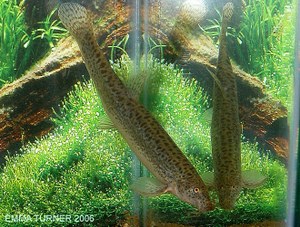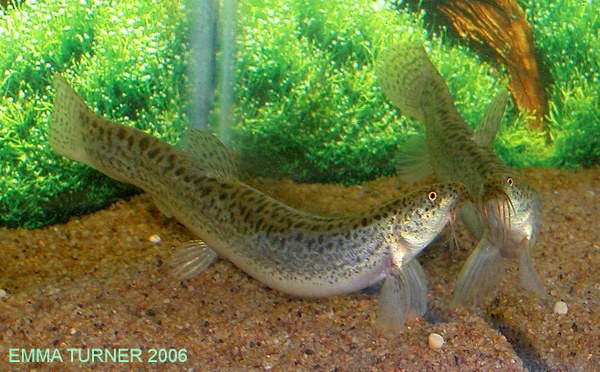Weather Report - Keeping Misgurnus anguillicaudatus
Introduction
![]()
Whilst the Weather Loach (Misgurnus anguillicaudatus) may not be the most striking-looking fish you have ever come across, their fascinating behaviour and endearing personality more than makes up for it.
Native to Myanmar, much of North-eastern Asia, and down on towards central China, this loach, member of the family Cobitidae, can be found in a huge number of water systems ranging from flowing rivers and streams, to the quieter waters of swamps, ponds, and rice-fields. Here these intriguing ‘eel-shaped’ loaches find sanctuary in the silt- or mud-rich substrates where they meander about through the leaf litter and rest with just their heads protruding from the often dense cover.
Aquarium Keeping:
![]()
The peacefulness and hardiness of this species makes it an ideal aquarium candidate. They are very easy to care for, and should be maintained in small groups so that they can interact socially, and so that you, the fishkeeper, get to observe their playful antics.
In the wild, Weather Loaches are found living within a surprisingly large temperature range, dependent on their location. In the aquarium, they should be kept at a steady sub-tropical temperature, somewhere within the range 15-25oC. They have been known to tolerate both lower and higher extremes, but they will feel most comfortable within this range.
Adults can reach a length of up to 25cm (10”), with slightly larger wild specimens reported. This size dictates the proportions of the aquarium that they should be housed in as being a minimum of 36” long when juvenile, and at least 48” long when adult. The tank should also be as wide as possible, so that the fish have a large ‘footprint’ in which to explore, and well-covered, to prevent these expert jumpers from escaping. They will enjoy travelling through the substrate, so it should consist of something smooth and soft, such as aquatic sand. If you must use gravel, do ensure that it is a very fine grade and smooth to the touch, as anything sharp could damage their ‘scale-less’ skin and delicate barbels.
Although this species is often considered as relatively forgiving of less-than-ideal water conditions, it is no excuse to let things slip. As with all loaches, good filtration, and a frequent partial water change regime will be the key to your fish’s wellbeing.
Plants tolerant of temperate conditions can be grown in the Weather Loach aquarium, but they do tend to mischievously uproot them with their digging. Placing small rock piles or pieces of bogwood around the stems can help to prevent this from happening, or instead invest in species such as Anubias, Java Fern, and Java Moss which can be tied onto and trained to grow on bogwood pieces. |  |
| Weather Loaches will accept many foods, but be sure to offer them a good variety. Some specimens will even eat small snails which may be present in the aquarium, searching them out with their five pairs of sensory barbels. |
Sinking pellets and frozen foods such as mosquito larvae and Daphnia will be very eagerly taken, and you may even find that the fish will feed from your hand. In fact, it is well known that this species seems to enjoy human contact - for instance, when someone is carrying out some maintenance in the aquarium, they often actively seek out the fishkeepers hands, which in their opinion are worthy of much investigation! They are never aggressive towards the hands, just incredibly curious.
You should provide your Weather Loaches with several hiding places, as although they can be very active fish, they tend to rest for the best part of the day and ‘come to life’ in the evening time and during the night.
They can be safely kept with most temperate community fishes, but avoid any species which could be easily spooked by your loaches sudden, unpredictable desire to dart around the aquarium. Anything aggressive should also be avoided, as should any really tiny fish or fry. Good choices include Lake Tebera Rainbowfish (Melanotaenia herbertaxelrodi), Variatus Platies (Xiphophorus variatus), Golden Barbs (Puntius semifasciolatus var.), Rosy Barbs (Puntius conchonius), Red Phantom Tetras (Hyphessobrycon sweglesi), and Argentine Bloodfins (Aphyocharax anisitsi). Weather Loaches can also be kept with many varieties of goldfish, although it is not a good idea to mix goldfish with any of the aforementioned smaller temperate community fish species.
The standard colouration of this fish is a yellowy-brown body, mottled with dark green-grey to dark brown speckles, and with a lighter coloured belly. A small and often indistinct dark blotch is present on the upper end of the body, at the junction with the caudal fin. A rarer ‘gold’ variety also exists and is much sought after by aquarists.
 |  |
These range from an overall yellow to orange or pinkish colour and sometimes sport faintly coloured markings or blotches. The vast majority are not true albinos, as they have dark eyes, although the occasional albino does turn up from time to time in batches of the gold variety. These variants of the same species mix absolutely fine together in the aquarium.
Adaptations:
![]()

Their ability to produce a layer of mucus to keep themselves moist also comes in useful when they find themselves out of water – for instance, in a temporary pool which dries up, or if they make a successful bid for freedom from an uncovered aquarium. Coupled with the ability to breathe atmospheric air, many a panicking aquarist has been mightily relieved when, after finding their Weather Loach on the floor (where it may have been for several hours), they have returned the fish to the aquarium to find that it made a ‘miraculous recovery’. These remarkable creatures have also been known to cross short stretches of land between waterways in damp or wet weather.
Introductions & Accidental Releases:
![]()
Over the years, Misgurnus anguillicaudatus have been carelessly introduced to the waterways of non-native countries, where they have since firmly established themselves. Sadly, at least one country, namely Australia, reports adverse ecological impact following their introduction during the 1980s. They have also been released in Italy, the Philippines, parts of the USA including Hawaii, and Germany, where breeding populations are now well established. This particular species is not considered a threat to water systems in the UK because temperatures drop too low for them during the winter period, hence why they are still available in UK shops. However, a similar species, Misgurnus fossilis, was banned from being imported into the UK a few years ago, as an accidental release of this species was considered to be a threat because of its ability to tolerate lower temperatures.
What’s in a Name?
![]()
Many of you will already know why members of the genus Misgurnus have been dubbed ‘Weather Loaches’ or ‘Weather Fish’, but for those who don’t, I will explain. The name came about because of their apparent sensitivity to changes in barometric pressure. It is said that these ‘living barometers’ show a dramatic increase in activity, for instance, if a storm is approaching. I have never witnessed this myself, but many fishkeepers (particularly those in parts of the US where more volatile weather systems prevail) maintain that this is definitely the case. As pressure drops, the loaches become restless, frantically swimming around the aquarium, sometimes jumping and splashing.
Breeding?
![]()
Reports of the captive spawning of Weather Loaches are few and far between. In the wild they spawn annually, after going through extreme seasonal changes. Rare aquarium spawnings have occurred when mature pairs have been subjected to higher than normal temperatures, given very frequent water changes, and conditioned with live or frozen foods. A sudden dramatic increase in flow appears to be the final piece of the puzzle that has apparently triggered spawning. Large batches of small adhesive eggs were reported to have been laid near to the outlets of filters and powerheads.

If you wish to sex your Weather Loaches, you will need to take a look at their pectoral fins. Mature males have a thicker and longer second ray, giving these fins an almost triangular appearance. The females’ pectoral fins are rounder by comparison, and they are often fuller in the belly region.
And finally, do remember that loaches are notoriously difficult to breed. Many alleged spawnings have never been backed up with proof. If you do have any degree of success with yours, please take photographs and as many notes as possible, as this will be invaluable to other loach enthusiasts.
![]()
Original article by Emma Turner first published in Tropical World Magazine, Issue #12. Adapted for Loaches Online with kind permission.
Images by Emma Turner and Ken Childs.
Document Actions



